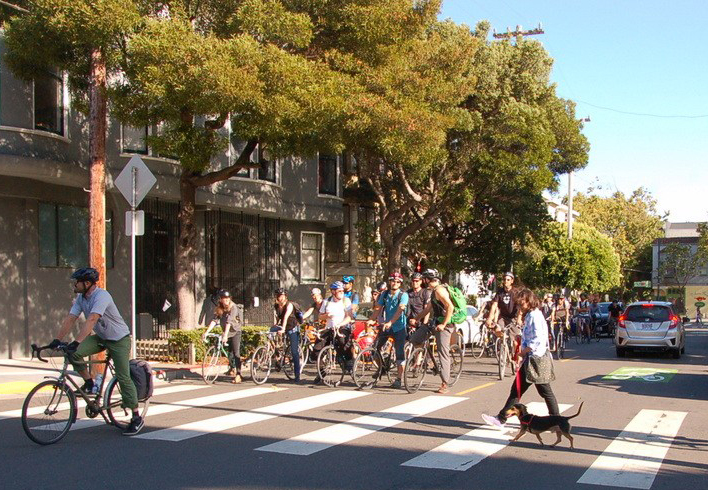Richard Masoner at Cyclelicious has a roundup of new bicycle-related bills introduced just before California's deadline on Friday. Two are big news, including one that should clarify the rules about what the law about staying to the right actually means.
A.B. 694, says Masoner,
as of this writing completely removes the text 'as close as practicable to the right-hand curb or edge of the roadway' and replaces it with more standard language for slow-moving vehicles.
The new law would now say that a person on a bicycle going slower than the rest of traffic “shall ride in the right-hand lane or bicycle lane, if one is present.” And the following exceptions would apply:
- When overtaking and passing another bicycle or vehicle proceeding in the same direction
- When preparing for a left turn at an intersection or into a private road or driveway
That means, continues Masoner:
If the cyclist is riding in a lane that’s 'wide enough for a vehicle and a bicycle to travel safely side by side,' then the cyclist must stay far enough right to allow faster traffic to pass, assuming no hazards.
It also clarifies that cyclists can legally move left “when approaching a place where a right turn is authorized,” something that is legal now, but not spelled out as such.
This bill validates the common 'vehicular cycling' practice of 'taking the lane,' which many A-to-B cyclists must practice on vast swaths of California roads where decent cycling infrastructure doesn’t exist.
Note that this bill is a second try from Assemblymember Phil Ting (D-San Francisco) to clarify what the rules about “riding as far to the right as practicable” actually means, and one of the motivations for the bill is so that the police understand the law.
Currently,
The law contains a list of exceptions which includes a 'substandard lane width' clause, but the abridged vehicle code cheat sheet used by California law enforcement agencies does not contain these exceptions, and side-of-the road appeals to the actual law or to common sense ('There’s literally not enough passing room!') are often met with a response of 'Take it to the judge.'
Masoner reports that Ting's earlier attempt, last year's A.B. 2509, was shelved but spurred further discussions among representatives of the California Bicycle Coalition and the California Association of Bicycle Organizations, who came up with this better, clearer rewording.
Another big-news bill Masoner mentions is A.B. 1103, which would allow cyclists to legally treat stop signs as yield signs. The bill has bipartisan support and several co-authors, including Assemblymembers Ting, Jay Obernolte (R-Hesperia), Richard Bloom (D-Santa Monica), Rocky Chavez (R-Oceanside), Kevin Kiley (R-Rocklin), and Senator Scott Wiener (D-San Francisco).
This subject gets a lot of hysterical pushback from people who can't recognize that some laws written for cars don't make sense for bicycle riders. Let's hope they read the bill before reacting. The current wording of the bill would authorize
a person operating a bicycle approaching a stop sign, after slowing to a reasonable speed and yielding the right-of-way, to cautiously make a turn or proceed through the intersection without stopping, unless safety considerations require otherwise.
It would also require a bicycle rider to signal an intention to turn, a reasonable and wise practice.
Also, two other bills remove sunset dates from earlier laws that exempt bicycle plans from CEQA review (A.B. 1218) and require traffic lights to be able to detect bicycles and motorcycles (S.B. 672).






